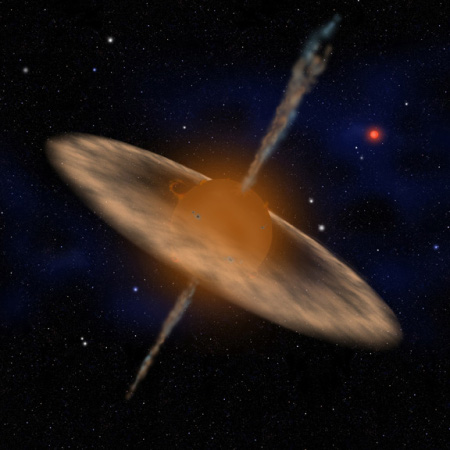Brown dwarfs raise plenty of questions, not the least of which is how they form. Work up to some fifteen times Jupiter’s mass and the planet in question starts to look more like a brown dwarf, a ‘failed star’ that cannot sustain fusion at its core. Somewhere around 75 Jupiter masses long-term fusion ignites and you’re in the territory of a true star. This brown dwarf zone between the two poles makes these objects provocative — do they form the way most planets seem to do by collecting more and more rocky materials and eventually a gas envelope?
Or does a brown dwarf form, like a star, through the gravitational collapse of a gas cloud? The latter idea gets a boost from recent work from the Harvard-Smithsonian Center for Astrophysics. Astronomers have now found a stream of carbon monoxide flowing out from a young brown dwarf known as ISO-Oph 102. This gets interesting at several levels, the first being that the outflow from the dwarf resembles what happens in larger stars as they form, a stream of ejected materials pushing out from two opposite jets. The process helps the young star shed angular momentum as it draws in material from the surrounding disk.

Image: This artist’s conception zooms in on the brown dwarf and its accretion disk. The discovery of a bipolar molecular outflow at ISO-Oph 102 offers the first strong evidence in favor of brown dwarf formation through gravitational collapse. Credit: David A. Aguilar (CfA)
The outflow from ISO-Oph 102, as we might expect, is considerably smaller than found in low-mass stars, as the paper points out:
We detect a bipolar molecular out?ow from the brown dwarf, demonstrating that this out?ow mechanism as seen in young stars continues to operate down to the masses of brown dwarfs. We show that the out?ow mass is much smaller than typical values found in low-mass stars by two to three orders of magnitude. We also combine our radio data with infrared data to estimate disk parameters. The infrared spectrum of ISO-Oph 102 shows strong crystalline silicate features. This demonstrates dust processing in the protoplanetary disk…of the brown dwarf. The coexistence of the molecular out?ow with the crystallization of dust grains could be of importance for models of planet formation.
So on the one hand, the picture of brown dwarfs forming through gravitational collapse is upheld, the major variable being the amount of disk material available, which would regulate how large a brown dwarf or star might emerge from a common star formation process. The other thing to note here is the impact on planetary formation around these objects. The authors surmise that the outflow from a brown dwarf may be longer lived than those coming from low-mass stars, perhaps a factor in sweeping gas out from the protoplanetary disk and forming rocky worlds.
The paper is Phan-Bao et al., “First Confirmed Detection of a Bipolar Molecular Outflow from a Young Brown Dwarf,” in press at Astrophysical Journal Letters and available online.


Hi Paul;
The formation of brown dwarfa intrigues me. I sometimes wonder if such failed stars could be stoked with long half life elements such as U-238 or perhaps with some of the meta-stable elements with a half life as great as of 10 EXP 20 years wherein the meta stable elements would be included in the brown dwarf in the amount of about 10 EXP 22 to 10 EXP 24.5 metric tons. Assuming that some radionuclides convert about 0.1 percent of their mass into energy when they decay, 10 EXP 24.5 metric tons of such a radionuclide deposited within a brown dwarf might permit the brown dwarf to give off the equivalent of about 30 metric tons of matter converted into energy per second. This power output is about 1/3 that of a low end M class star which is about 1/10,000 the power output of the Sun. A planet located within about 0.01 AU to about 0.02 AU of such a brown dwarf with a lot of green house C02 in its atmosphere might be a nice and warm environment for advanced humans and/or ETI persons to live on.
I would imagine that such an artificially heated brown dwarf might look very deep red or redish brown to the currently evolved human eye. I think that the image of such an artificially heated brown dwarf would be a cool feature in a science fiction movie.
Regardless, heating such brown dwarfs in such a manner might permit stellar like planetary systems to support human life and carbon based ETI life for as great as 10 EXP 20.5 years, about 10 EXP 5.5 or 300,000 times longer than the coolest burning M class stars.
I consideration of such possibilities, the study of brown dwarf dynamics seems important.
The possibility of seeding brown dwarfs with U-238 which has a half life of roughly 10 billion years might entail an excellent means to produce solar system like habitats for our species in the case that such brown dwarfs are not already occupied by ETI civilizations.
Thanks;
Jim
There was some study done which showed that massive brown dwarfs could sustain habitable planets for several billion years. (One might imagine that even after this habitability window, life could still survive in oceans under ice layers, somewhat like Europa)
As for ISO-Oph 102, it is interesting to contrast this with the ~20 Jupiter mass companions of HD 202206 and HW Virginis, which strongly suggest that it is perfectly possible to form planets in a disc which exceed the deuterium fusion limit. (Indeed there does not seem to be a reason why the ability of an object to perform deuterium fusion should have an effect on the formation process).